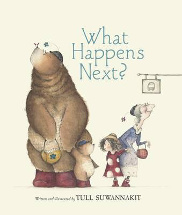What happens next? by Tull Suwannakit

Walker Books, 2014. ISBN 9781922077561.
(Ages: 4-6) Highly recommended. Grandparents. Imagination. When
Granny takes her granddaughter, Little Ellie for a walk, she tells
her of the bear family, also going for a walk. Little Ellie asks
questions of her Granny, questioning her on the bears' habits and
practices. All the while, Little Ellie watches the bear family as
they walk behind, following their every move, and as each part of
the story continues, Little Ellie asks, 'what happens next?', a
refrain repeated on each double page. But when Granny looks behind
and sees the bear family for herself, it is her turn to ask of
Little Ellie, 'what happens next?' as she backs away from the bears,
ready to flee.
Unfazed, Little Ellie and Granny go into the woods with the bear
family where they meet a number of other animals, even an ogre, and
have a dinner of icecream, cakes and honey, before Little Ellie and
Granny go home, where the child is tucked into bed.
The transposing of ideas is wonderful, with Little Ellie imagining
the family behind her as Granny tells her the story, and then taking
shape as Granny and the girl follow the bears after Granny's initial
fear, to going to the woods and then back home. The shift from
imagination to reality occurs all through the story, encouraging the
reader to ponder over which is real and which is not. But over all
is the sense of the care and safety of the family unit.
The stunning watercolour illustrations are a treat to read and
reread. From the enticing front cover to the alluring endpapers to
the inside illustrations of the story itself, the two families are
paralleled. The hats of the two Grannies, the handbags and shoes of
each participant, the small animals that keep peeping through on
most pages, to the wonderful display in the shop, then the dinner at
the bear's house, each page is meticulous in its presentation of the
story, keeping the reader's interest. I loved the image of the two
Grannies with their noses in the air, while their offspring talked
to each other. The little images of frogs, rabbits, the birds on the
bus stop sign, the sleeping fox on the bus, the animals at dinner,
all will elicit a laugh from the audience, while the last endpaper
with the group standing together is a lovely contrast to the front
cover.
An astute teacher will use this to remind children of other stories
of bears, of other tales of ogres and stories which have an element
of 'what happens next?' as they proceed. And they could even be
encouraged to write their own.
Fran Knight